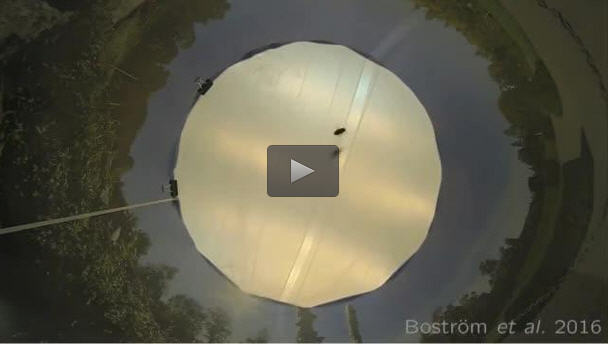Small birds' vision: Not so sharp but superfast

The video clip visualizes one advantage of the ultra rapid vision discovered in birds. The almost three times faster refreshment rate of visual input in a pied flycatcher than in a human makes it far easier to track and predict the flight paths of two blue bottle flies. This is most likely a crucial ability for a bird that catches its airborne prey on the wing. Credit: Malin Thyselius
In behavioural experiments, the scientists have studied the ability to resolve visual detail in time in three small wild passerine species: blue tit, collared flycatcher and pied flycatcher. This ability is the temporal resolution of eyesight, i.e. the number of changes per second an animal is capable of perceiving. It may be compared to spatial resolution (visual acuity), a measure of the number of details per degree in the field of vision.
The researchers trained wild-caught birds to receive a food reward by distinguishing between a pair of lamps, one flickering and one shining a constant light. Temporal resolution was then determined by increasing the flicker rate to a threshold at which the birds could no longer tell the lamps apart.
This threshold, known as the CFF (critical flicker fusion rate), averaged between 129 and 137 hertz (Hz). In the pied flycatchers it reached as high as 146 Hz, some 50 Hz above the highest rate encountered for any other vertebrate. For humans, the CFF is usually approximately 60 Hz. For passerines, the world might to be said to be in slow motion compared with how it looks to us.
It has been argued before, but never investigated, that small and agile wild birds should have extremely fast vision. Nevertheless, the blue tits and flycatchers proved to have higher CFF rates than were predicted from their size and metabolic rates. This indicates an evolutionary history of natural selection for fast vision in these species.
The explanation might lie in small airborne birds' need to detect and track objects whose image moves very swiftly across the retina — for blue tits, for example, to be able to see and avoid all branches when they take cover from predators by flying straight into bushes. Moreover, the three avian species investigated all, to a varying degree, subsist on the insects they catch. Flycatchers, as their name suggests, catch airborne insects. For this ability, aiming straight at the insect is not enough. Forward planning is required: the bird needs high temporal resolution to track the insect's movement and predict its location the next instant.
The new results give some cause for concern about captive birds' welfare. Small passerines are commonly kept in cages, and may be capable of seeing roughly as fast as their wild relatives. With the phase-out of incandescent light bulbs for reasons of energy efficiency, tame birds are increasingly often kept in rooms lit with low-energy light bulbs, fluorescent lamps or LED lighting. Many of these flicker at 100 Hz, which is thus invisible to humans but perhaps not to small birds in captivity. Studies have shown that flickering light can cause stress, behavioural disturbances and various forms of discomfort in humans and birds alike.
Of all the world's animals, the eagle has the sharpest vision. It can discern 143 lines within one degree of the field of vision, while a human with excellent sight manages about 60. The magnitude of this difference is almost exactly the same as between a human's top vision speed and a pied flycatcher's: 60 and 146 Hz respectively. Thus, the flycatcher's vision is faster than human vision to roughly the same extent as an eagle's vision is sharper. So small passerines' rapid vision is an evolutionary adaptation just as impressive as the sharp eyesight of birds of prey.
Anders Ödeen, the lecturer at Uppsala University's Department of Ecology and Genetics who headed the study, puts the research findings in perspective.
'Fast vision may, in fact, be a more typical feature of birds in general than visual acuity. Only birds of prey seem to have the ability to see in extremely sharp focus, while human visual acuity outshines that of all other bird species studied. On the other hand, there are lots of bird species similar to the blue tit, collared flycatcher and pied flycatcher, both ecologically and physiologically, so they probably also share the faculty of superfast vision.'
###
Jannika Boström, Marina Dimitrova, Cindy Canton, Olle Håstad, Anna Qvarnström, Anders Ödeen (2016) Ultra-rapid Vision in Birds, PLOS ONE
Link to manuscript once it goes live: http://dx.
Media Contact
All latest news from the category: Life Sciences and Chemistry
Articles and reports from the Life Sciences and chemistry area deal with applied and basic research into modern biology, chemistry and human medicine.
Valuable information can be found on a range of life sciences fields including bacteriology, biochemistry, bionics, bioinformatics, biophysics, biotechnology, genetics, geobotany, human biology, marine biology, microbiology, molecular biology, cellular biology, zoology, bioinorganic chemistry, microchemistry and environmental chemistry.
Newest articles

Properties of new materials for microchips
… can now be measured well. Reseachers of Delft University of Technology demonstrated measuring performance properties of ultrathin silicon membranes. Making ever smaller and more powerful chips requires new ultrathin…

Floating solar’s potential
… to support sustainable development by addressing climate, water, and energy goals holistically. A new study published this week in Nature Energy raises the potential for floating solar photovoltaics (FPV)…

Skyrmions move at record speeds
… a step towards the computing of the future. An international research team led by scientists from the CNRS1 has discovered that the magnetic nanobubbles2 known as skyrmions can be…





















